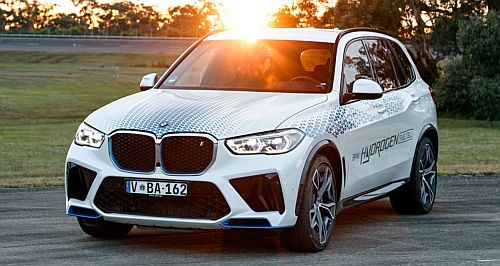Hydrogen a longer-term target: BMW

BMW says its hydrogen vehicle program in one with longer-term goals that aims to ultimately supplement, and not replace, electric vehicles.
At the same time, the Bavarian automotive manufacturer says hydrogen fuel-cell electric vehicles will offer greater choice to users who require quicker refilling, additional power for towing, and/or greater travel distances from their zero emissions vehicle.
Introducing its iX5 Hydrogen FCEV to Australian journalists in Melbourne this week, BMW Group general project manager of hydrogen technology and vehicle project Dr Juergen Guldner said the pilot vehicles currently touring Australia could enter production in larger segments, countering battery electric models in smaller and city-centric segments.
“It really depends on the use case... we see a portion of the use cases to be better suited to hydrogen than battery technology. (But) we don’t see it as a competition between the two technologies, we think the two technologies complement one another,” he explained.
“The best thing we can do is to offer options. BMW is technology agnostic (and) we want to give our customers the right powertrain to suit their individual needs.”
Dr Guldner said much of the technology offered in the pilot vehicles closely resembles that of BMW’s electric models, with minimal changes required from both driveline and software standpoints.
Further, the addition of the fuel cell stack and hydrogen tanks aids in reducing vehicle weight (by 100kg or more) when compared with a direct battery electric counterpart, while also using fewer resources to produce.
“The cars are very similar. The electric motor that drives our hydrogen cars is the same electric motor that drives our ‘i’ cars, in this case the iXM which shares the same chassis,” he added.
“The only difference is that in a hydrogen car, the energy is stored as hydrogen and not as electricity in a battery. The hydrogen is converted into electricity in the car using the fuel cell system.”
That system is supplied by Toyota and is the same found in the Japanese company’s Mirai FCEV sedan. BMW has ‘tweaked’ the unit to provide more power, enabling the iX5 Hydrogen to deliver higher energy levels at a constant rate when viewed against the Mirai’s arrangement.
“The iX5 Hydrogen offers all the advantages of electric driving – the silent ride and the fully electric acceleration – with the zero vehicle emissions of only water vapour. That is the beauty of it.
“Plus, you can refuel it in three- to four minutes, just like the petrol-powered car we’ve used for more than 100 years.”
The BMW iX5 Hydrogen FCEV is powered by a fuel-cell electric hybrid system comprising three carbon-fibre reinforced plastic (CFRP) tanks that store up to six kilograms of hydrogen under 700 bar of pressure.
The fuel cell produces a constant 125kW of power to a 400-volt lithium-ion battery with around 2.0kWh of usable capacity. It offers something of a power buffer to the electric motors while also serving to gather regenerative energy from the braking system.
The two-wheel drive (rear) iX5 Hydrogen FCEV offers total system power rated at 295kW with a driving range of 504km (WLTP).
BMW’s pilot program will investigate the business case for hydrogen-powered vehicles in the longer-term, with Dr Guldner estimating the vehicle –and those like it – could be production ready by as early as the end of the decade.
“We’re just looking at the right point in time to launch. We have been doing crash testing and fire testing, endorsed testing, vibration testing, and we’ve been doing road testing with this fleet,” he said of the two pilot vehicles.
“We’ve been in the desert and in the cold. Hot, humid, high altitude, and so on. We have looked at everything and the cars have performed to our full satisfaction. We know that if we decide to go into (series) production we have a good basis of understanding of the technology.
“We are prepared to launch a vehicle within this decade. We have been working as BMW on hydrogen for 40 years. It’s not unusual for us that something (like this could) take a few decades.
“Once we have made the decision, we have to develop the car (for series production) which would take a few years. Then we will decide on which markets are ready to take up the technology,” he added.
Obviously, the infrastructure required to support a hydrogen powered vehicle fleet is vital to the success of the technology. Australia currently has just 12 hydrogen refuelling stations, though not all are available to the general public.
Dr Guldner said that with the right investment – and in using solar and other renewables to generate hydrogen fuel – Australia could be an ideal candidate for a hydrogen refuelling network similar to that proposed for the European Union.
From 2030, the EU will mandate the installation of hydrogen refuelling stations at 200km intervals, supporting the ability for longer distance travel in a similar scale to that which would be needed Down Under.
“There are a lot of places that already have infrastructure (in place), like California, Europe, Japan, Korea, and China. There are also a lot of countries that are interested in building infrastructure, like Australia,” he stated.
“Hydrogen is ideal for Australia because you have a lot of solar and wind (generation), so you can produce a lot of hydrogen for use or export. You also have long travel distance and metropolitan areas where electric vehicle charging at scale could be an issue.
“All the ingredients are there,” he enthused.
Visit GoAuto again soon for our Australian test drive of the 2024 BMW iX5 Hydrogen FCEV.